Related Research Articles

Giovanni Boccaccio was an Italian writer, poet, correspondent of Petrarch, and an important Renaissance humanist. Born in the town of Certaldo, he became so well known as a writer that he was sometimes simply known as "the Certaldese" and one of the most important figures in the European literary panorama of the fourteenth century. Some scholars define him as the greatest European prose writer of his time, a versatile writer who amalgamated different literary trends and genres, making them converge in original works, thanks to a creative activity exercised under the banner of experimentalism.

Leonardo di ser Piero da Vinci was an Italian polymath of the High Renaissance who was active as a painter, draughtsman, engineer, scientist, theorist, sculptor, and architect. While his fame initially rested on his achievements as a painter, he has also become known for his notebooks, in which he made drawings and notes on a variety of subjects, including anatomy, astronomy, botany, cartography, painting, and paleontology. Leonardo is widely regarded to have been a genius who epitomized the Renaissance humanist ideal, and his collective works comprise a contribution to later generations of artists matched only by that of his younger contemporary Michelangelo.

Santa Maria Novella is a church in Florence, Italy, situated opposite, and lending its name to, the city's main railway station. Chronologically, it is the first great basilica in Florence, and is the city's principal Dominican church.
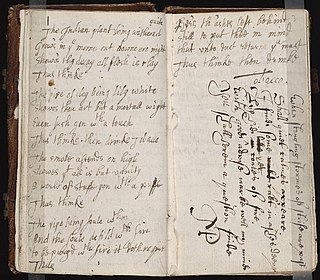
Commonplace books are a way to compile knowledge, usually by writing information into books. They have been kept from antiquity, and were kept particularly during the Renaissance and in the nineteenth century. Such books are similar to scrapbooks filled with items of many kinds: notes, proverbs, adages, aphorisms, maxims, quotes, letters, poems, tables of weights and measures, prayers, legal formulas, and recipes.

Italian literature is written in the Italian language, particularly within Italy. It may also refer to literature written by Italians or in other languages spoken in Italy, often languages that are closely related to modern Italian, including regional varieties and vernacular dialects.
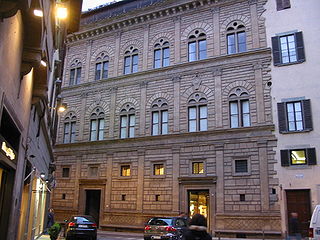
Palazzo Rucellai is a palatial fifteenth-century townhouse on the Via della Vigna Nuova in Florence, Italy. The Rucellai Palace is believed by most scholars to have been designed for Giovanni di Paolo Rucellai by Leon Battista Alberti between 1446 and 1451 and executed, at least in part, by Bernardo Rossellino. Its splendid facade was one of the first to proclaim the new ideas of Renaissance architecture based on the use of pilasters and entablatures in proportional relationship to each other. The Rucellai Palace demonstrates the impact of the antique revival but does so in a manner which is full of Renaissance originality.
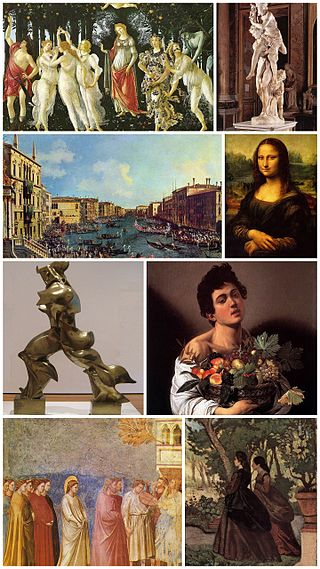
The cultural and artistic events of Italy during the period 1500 to 1599 are collectively referred to as the Cinquecento, from the Italian for the number 500, in turn from millecinquecento, which is Italian for the year 1500. Cinquecento encompasses the styles and events of the High Italian Renaissance, and Mannerism.
Giovanni Branca was an Italian engineer and architect, chiefly remembered today for what some commentators have taken to be an early steam turbine.
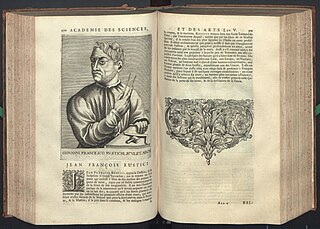
Giovan Francesco Rustici, or Giovanni Francesco Rustici, (1475–1554) was an Italian Renaissance painter and sculptor. He was born into a noble family of Florence, with an independent income. Rustici profited from study of the Medici sculpture in the garden at San Marco, and according to Giorgio Vasari, Lorenzo de' Medici placed him in the studio of Verrocchio, and that after Verrocchio's departure for Venice, he placed himself with Leonardo da Vinci, who had also trained in Verocchio's workshop. He shared lodgings with Leonardo while he was working on the bronze figures for the Florence Baptistry, for which he was ill paid and resolved, according to Vasari, not to work again on a public commission. Moreover, an echo of Leonardo's inspiration is unmistakable in the much-discussed and much-reviled wax bust of "Flora" in Berlin, ascribed to a circle of Leonardo and most probably to Rustici. At this time, Pomponius Gauricus, in De sculptura (1504), named him one of the principal sculptors of Tuscany, the peer of Benedetto da Maiano, Andrea Sansovino and Michelangelo. It may have been made in France, perhaps in the circle of Rustici, who entered Francis I's service in 1528.
Dionigi di Borgo San Sepolcro OESA was an Augustinian friar who was at one time Petrarch's confessor, and who taught Boccaccio at the beginning of his education in the humanities. He was Bishop of Monopoli in Apulia. He was surnamed, not uncommonly for the trecento, for the town in which he was born, now Sansepolcro in Tuscany. His family name was de' Roberti, which no longer exists. Dionigi is the Italian form of Dennis, Latin Dionysius.
Events from the year 1525 in art.
The Platonic Academy of Florence was an informal discussion group which formed around Marsilio Ficino in the Florentine Renaissance of the fifteenth century.

The Decameron, subtitled Prince Galehaut and sometimes nicknamed l'Umana commedia, is a collection of short stories by the 14th-century Italian author Giovanni Boccaccio (1313–1375). The book is structured as a frame story containing 100 tales told by a group of seven young women and three young men; they shelter in a secluded villa just outside Florence in order to escape the Black Death, which was afflicting the city. Boccaccio probably conceived of the Decameron after the epidemic of 1348, and completed it by 1353. The various tales of love in The Decameron range from the erotic to the tragic. Tales of wit, practical jokes, and life lessons contribute to the mosaic. In addition to its literary value and widespread influence, it provides a document of life at the time. Written in the vernacular of the Florentine language, it is considered a masterpiece of early Italian prose.

Bernardo Rucellai, also known as Bernardo di Giovanni Rucellai or Latinised as Bernardus Oricellarius, was a member of the Florentine political and social elite. He was the son of Giovanni di Paolo Rucellai (1403–1481) and father of Giovanni di Bernardo Rucellai (1475–1525). He was married to Nannina de' Medici, the elder sister of Lorenzo de' Medici, and was thus uncle to Popes Leo X and Clement VII, who were cousins. Oligarch, banker, ambassador and man of letters, he is today remembered principally for the meetings of the members of the Accademia Platonica in the Orti Oricellari, the gardens of his house in Florence, the Palazzo Rucellai, where Niccolò Machiavelli gave readings of his Discorsi.
Bucolicum carmen is an organic collection of twelve eclogues, composed by Petrarch from c. 1346–7 and published in 1357. The last (Aggelos) contains the dedication of the sylloge to Donato Albanzani.

The Leonardeschi were the large group of artists who worked in the studio of, or under the influence of, Leonardo da Vinci. They were artists of Italian Renaissance painting, although his influence extended to many countries within Europe.
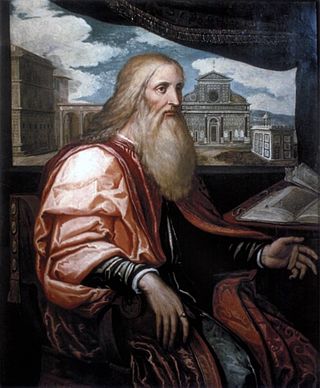
Giovanni Rucellai, known by his name with the patronymic Giovanni di Paolo Rucellai, was a member of a wealthy family of wool merchants in Renaissance Florence, in Tuscany, Italy. He held political posts under Cosimo and Lorenzo de' Medici, but is principally remembered for building Palazzo Rucellai and the Rucellai Sepulchre, for his patronage of the marble façade of the church of Santa Maria Novella, and as author of an important Zibaldone. He was the father of Bernardo Rucellai (1448–1514) and grandfather of Giovanni di Bernardo Rucellai (1475–1525).

Giovanni Rucellai, known as Giovanni di Bernardo Rucellai, was an Italian humanist, poet, dramatist and man of letters in Renaissance Florence, in Tuscany, Italy. A member of a wealthy family of wool merchants and one of the richest men in Florence, he was cousin to Pope Leo X and linked by marriage to the powerful Strozzi and de' Medici families. He was born in Florence, and died in Rome. He was the son of Bernardo Rucellai (1448–1514) and his wife Nannina de' Medici (1448–1493), and the grandson of Giovanni di Paolo Rucellai (1403–1481). He is now remembered mostly for his poem Le Api, one of the first poems composed in versi sciolti to achieve widespread acclaim.
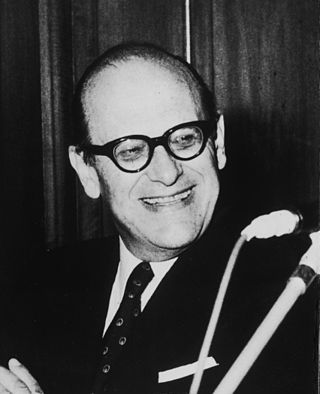
Vittore Branca was a philologist, literary critic, and Italian academic. He was a professor emeritus of Italian literature at the University of Padua until his death in 2004, and one of the most acclaimed contemporary scholars of Italian author and poet Giovanni Boccaccio.
Giovanni Boccaccio's notebooks or zibaldoni have been preserved in three codices, known as the Zibaldone Laurenziano, the Miscellanea Laurenziana and the Zibaldone Magliabechiano. These are autograph manuscripts containing both texts copied by Boccaccio and original compositions, plus many notes. All three date from his early years in Naples and Florence.
References
- ↑ Giaimo, Cara (2016-08-29). "How to Keep a Zibaldone, the 14th Century's Answer to Tumblr". Atlas Obscura. Retrieved 2017-07-22.
- ↑ Grande Dizionario della lingua italiana, ed. Salvatore Battaglia, s.v. “zibaldone.” https://www.gdli.it/sala-lettura/vol/21?seq=1080
- ↑ Murano, Giovanna. “Zibaldoni,” Scriptorium, 67, 2013, 406.
- ↑ De Rosa, Gabriele. Cicchetti and Mordenti I Libri di famiglia in Italia Vol. 1 of La Memoria familiare Rome, 1985, p. ix.
- ↑ Kaborycha, Lisa. “Copying Culture: Fifteenth-Century Florentines and Their Zibaldoni.” Ph.D. diss., University of California, Berkeley, 2006, 103.
- ↑ Pollick, Brian. “Copy That! The Cultural and Social Role of Late-Medieval Venetian Zibaldoni,” ARTiculate, Vol. 3, Fall 2019, University of Victoria, 5–31. https://journals.uvic.ca/index.php/articulate/article/view/19318
- ↑ Black, Robert. Education and Society in Florentine Tuscany: Teachers, Pupils and Schools c.1250-1500 Brill, 2007, 42.
- ↑ Branca,Vittore. “Copisti per passione, tradizione caratterizzante, tradizione di memoria,” in Studi e problemi di critica testuale. Convegno di Studi di Filologia italiana nel Centenario della Commissione per I Testi di Lingua (7-9 Aprile 1960), Bologna, 1961, p.70.
- ↑ Cazalé Bérard, Claude (2013). "Boccaccio's Working Notebooks (Zibaldone Laurenziano, Miscellanea Laurenziana, Zibaldone Magliabechiano)". In Victoria Kirkham; Michael Sherberg; Janet Levarie Smarr (eds.). Boccaccio: A Critical Guide to the Complete Works. University of Chicago Press. pp. 307–318.
- ↑ Giovanni di Pagolo Rucellai Zibaldone; a cura di Gabriella Battista ; prefazione di Anthony Molho. Firenze : SISMEL - Edizioni del Galluzzo, 2013.
- ↑ Giovanni Rucellai. ed il suo Zibaldone, II, 2 vols., Studies by F.W. Kent, Alessandro Perosa, Brenda Preyer, Piero Sanpaolesi and Roberto Salvini. With an introduction by Nicolai Rubinstein. London: The Warburg Institute, University of London, 1960-1981.
- ↑ Codice Rustici: dimostrazione dell'andata o viaggio al Santo Sepolcro e al monte Sinai di Marco di Bartolomeo Rustici: facsimile del manoscritto della Biblioteca del Seminario arcivescovile maggiore di Firenze. Olschki, 2015.
- ↑ Vecce, Carlo. “Word and image in Leonardo's writings” in Leonardo da Vinci, master draftsman, edited by Carmen C. Bambach ; with contributions by Carmen C. Bambach [and others] ; with the assistance of Rachel Stern and Alison Manges. Metropolitan Museum of Art; New Haven: Yale University Press, 2003. https://books.google.it/books?id=QwQxDJMKRE4C&printsec=frontcover&redir_esc=y&hl=it#v=onepage&q&f=false
- ↑ Kent, Dale. Cosimo de’ Medici and the Florentine Renaissance: The Patron’s Oeuvre, Yale Univ. Press, 2000, 69.
- ↑ Kaborycha, Lisa. “Copying Culture: Fifteenth-Century Florentines and Their Zibaldoni.” Ph.D. diss., University of California, Berkeley, 2006, pp. ii-iii.
- ↑ "Zibaldone - Zeitschrift fr italienische Kultur der Gegenwart". www.stauffenburg.de (in German). Retrieved 2017-07-22.